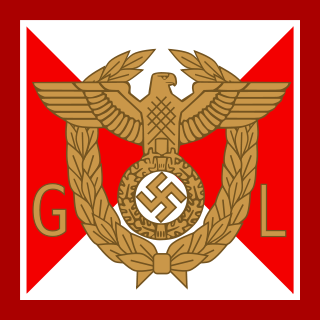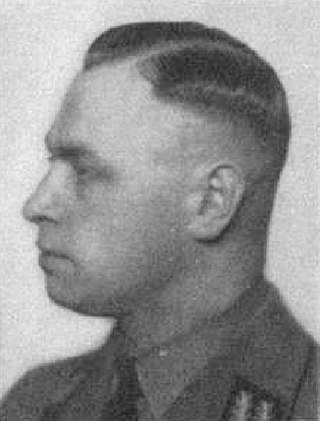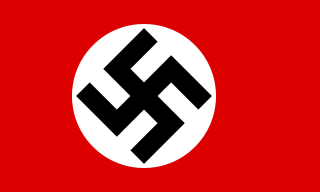
Ernst Friedrich Christoph "Fritz" Sauckel was a German Nazi politician, Gauleiter of Gau Thuringia from 1927 and the General Plenipotentiary for Labour Deployment (Arbeitseinsatz) from March 1942 until the end of the Second World War. Sauckel was among the 24 persons accused in the Nuremberg Trial of the Major War Criminals before the International Military Tribunal. He was found guilty of war crimes and crimes against humanity, sentenced to death, and executed by hanging.

A Gauleiter was a regional leader of the Nazi Party (NSDAP) who served as the head of a Gau or Reichsgau. Gauleiter was the third-highest rank in the Nazi political leadership, subordinate only to Reichsleiter and to the Führer himself. The position was effectively abolished with the fall of the Nazi regime on 8 May 1945.

Friedrich Karl Florian was the Gauleiter of Gau Düsseldorf throughout its existence in Nazi Germany.

Josef Grohé was a German Nazi Party official. He was the long-serving Gauleiter of Gau Cologne-Aachen and Reichskommissar for Belgium and Northern France toward the end of the Second World War.

Gau Swabia, formed on 1 October 1928, was an administrative division of Nazi Germany in Swabia, Bavaria, from 1933 to 1945. From 1928 to 1933, it was the regional subdivision of the Nazi Party in that area.

The Gau Westmark was an administrative division of Nazi Germany from 1933 to 1945. From 1925 to 1933, it was a regional subdivision of the Nazi Party.

Karl Wahl was the Nazi Gauleiter of Gau Swabia from the Gau inception in 1928 until the collapse of Nazi Germany in 1945. After the war, Wahl spent 3½ years in jail before being released in 1949. In 1954, he became the first former Gauleiter to publish his autobiography.

Gau East Prussia was an administrative division of Nazi Germany encompassing the province of East Prussia in the Free State of Prussia from 1933 to 1945. Before that, from 1925 to 1933, it was the regional subdivision of the Nazi Party in that area, having been established at a conference in Königsberg on 6 December 1925. In 1939, Gau East Prussia expanded following the annexation of the Klaipėda Region from Lithuania and the occupation of Poland, while a sliver of territory from the gau was transferred to Reichsgau Danzig-West Prussia. After Germany's attack on the USSR, the Belarusian city of Hrodna also became part of the Gau.

The Reichsgau Tyrol-Vorarlberg was an administrative division of Nazi Germany consisting of Vorarlberg and North Tyrol. It existed from 1938 to 1945. It did not include East Tyrol (Lienz), which was instead part of Reichsgau Carinthia.

The Reichsgau Salzburg was an administrative division of Nazi Germany in Salzburg, Austria. It existed between 1938 and 1945.

The Gau Westphalia-North was an administrative division of Nazi Germany encompassing the Free State of Lippe, the Free State of Schaumburg-Lippe and the northern half of the Prussian province of Westphalia between 1933 and 1945. From 1931 to 1933, it was the regional subdivision of the Nazi Party for these areas.

The Gau Baden, renamed Gau Baden–Alsace in March 1941, was a de facto administrative division of Nazi Germany from 1933 to 1945 in the German state of Baden and, from 1940 onwards, in Alsace. Before that, from 1925 to 1933, it was the regional subdivision of the Nazi Party in that area.

The Gau Saxony was an administrative division of Nazi Germany from 1933 to 1945 in the German state of Saxony. Before that, from 1926 to 1933, it was the regional subdivision of the Nazi Party in that area.

The Gau Essen was an administrative division of Nazi Germany from 1933 to 1945 in the northern parts of the Prussian Rhine Province. Before that, from 1928 to 1933, it was the regional subdivision of the Nazi Party in that area.

The Gau Cologne-Aachen was an administrative division of Nazi Germany from 1933 to 1945 in the north-central part of the Prussian Rhine Province. Before that, from 1931 to 1933, it was the regional subdivision of the Nazi Party in that area.

The Gau Electoral Hesse was an administrative division of Nazi Germany from 1933 to 1945, initially known under the name Gau Hesse-Nassau-North, comprising the northern part of the Prussian province of Hesse-Nassau. Before that, from 1925 to 1933, it was the regional subdivision of the Nazi Party in that area.

The Gau Weser-Ems, formed on 1 October 1928, was an administrative division of Nazi Germany from 1933 to 1945 in the core part of the Free State of Oldenburg, the state of Bremen and the western parts of the Prussian Province of Hanover. Before that, from 1928 to 1933, it was the regional subdivision of the Nazi Party in that area.

The Gau Westphalia-South was an administrative division of Nazi Germany encompassing the Arnsberg Region in the southern part of the Prussian province of Westphalia between 1933 and 1945. From 1931 to 1933, it was the regional subdivision of the Nazi Party for these areas.

The Gau Berlin was an administrative division of Nazi Germany from 1933 to 1945 in the German capital Berlin. Before that, from 1928 to 1933, it was the regional subdivision of the Nazi Party in that area. From 1926 to 1928 Berlin was part of the Gau Berlin-Brandenburg which was split into two separate Gaue on 1 October 1928.










